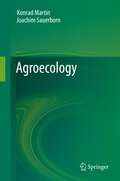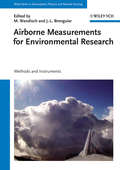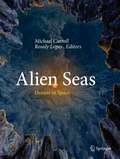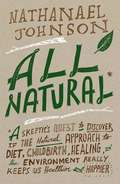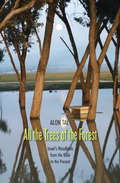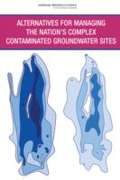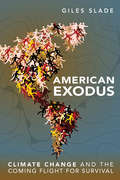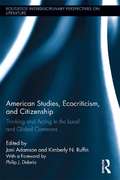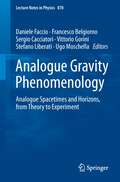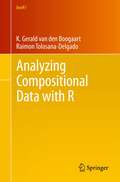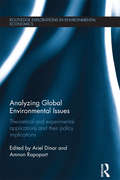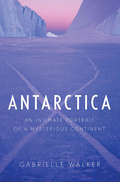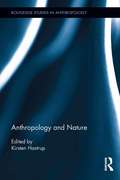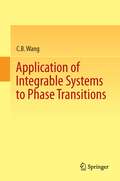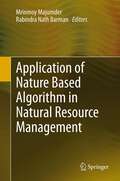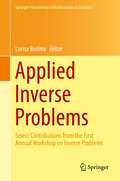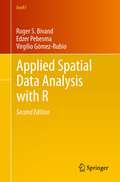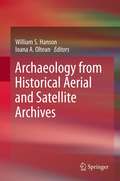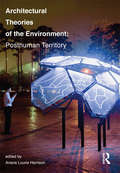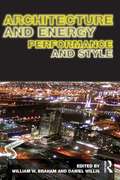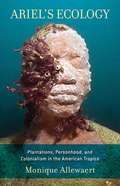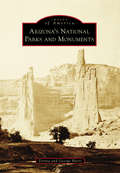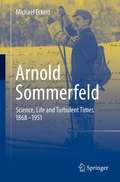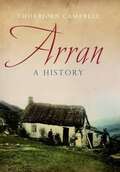- Table View
- List View
Agroecology
by Joachim Sauerborn Konrad MartinThis book represents an interdisciplinary approach to the relevant aspects of agricultural production related to the interactions between natural processes, human activities and the environment. It provides condensed and comprehensive knowledge on the functions of various agroecosystems at the field, landscape and global scale. Understanding and integrating complex ecological processes into field production, land management and food systems is essential in order to deal with the challenges of modern crop and livestock production: the need for food security for the growing human population, and the necessity to combat the detrimental effects of food production on the environment. The book provides the scientific basis required by students and scientists involved in the development of sustainable agroecosystems and contributes to a range of disciplines including Agriculture, Biology, Geography, Landscape Ecology, Organic Farming, Biological Control, and Global Change Ecology.
Airborne Measurements for Environmental Research
by Jean-Louis Brenguier Manfred WendischThis first comprehensive review of airborne measurement principles covers all atmospheric components and surface parameters. It describes the common techniques to characterize aerosol particles and cloud/precipitation elements, while also explaining radiation quantities and pertinent hyperspectral and active remote sensing measurement techniques along the way. As a result, the major principles of operation are introduced and exemplified using specific instruments, treating both classic and emerging measurement techniques.The two editors head an international community of eminent scientists, all of them accepted and experienced specialists in their field, who help readers to understand specific problems related to airborne research, such as immanent uncertainties and limitations. They also provide guidance on the suitability of instruments to measure certain parameters and to select the correct type of device. While primarily intended for climate, geophysical and atmospheric researchers, its relevance to solar system objects makes this work equally appealing to astronomers studying atmospheres of solar system bodies with telescopes and space probes.
Alien Seas: Oceans in Space
by Michael Carroll Rosaly LopesOceans were long thought to exist in all corners of the Solar System, from carbonated seas percolating beneath the clouds of Venus to features on the Moon's surface given names such as "the Bay of Rainbows" and the "Ocean of Storms." With the advent of modern telescopes and spacecraft exploration these ancient concepts of planetary seas have, for the most part, evaporated. But they have been replaced by the reality of something even more exotic. For example, although it is still uncertain whether Mars ever had actual oceans, it now seems that a web of waterways did indeed at one time spread across its surface. The "water" in many places in our Solar System is a poisoned brew mixed with ammonia or methane. Even that found on Jupiter's watery satellite Europa is believed similar to battery acid. Beyond the Galilean satellites may lie even more "alien oceans." Saturn's planet-sized moon Titan seems to be subject to methane or ethane rainfall. This creates methane pools that, in turn, become vast lakes and, perhaps, seasonal oceans. Titan has other seas in a sense, as large shifting areas of sand covering vast plains have been discovered. Mars also has these sand seas, and Venus may as well, along with oceans of frozen lava. Do super-chilled concoctions of ammonia, liquid nitrogen, and water percolate beneath the surfaces of Enceladus and Triton? For now we can only guess at the possibilities. 'Alien Seas' serves up part history, part current research, and part theory as it offers a rich buffet of "seas" on other worlds. It is organized by location and by the material of which various oceans consist, with guest authors penning specific chapters. Each chapter features new original art depicting alien seas, as well as the latest ground-based and spacecraft images. Original diagrams presents details of planetary oceans and related processes.
All Natural: A Skeptic's Quest to Discover if the Natural Approach to Diet, Childbirth, Healing, and the Environment Really Keeps Us Healthier and Happier
by Nathanael JohnsonIn this age of climate change, killer germs, and obesity, it's easy to feel as if we've fallen out of sync with the global ecosystem. This ecological anxiety has polarized a new generation of Americans: many are drawn to natural solutions and organic lifestyles, while others rally around high-tech development and industrial efficiencies. Johnson argues that both views, when taken to extremes, can be harmful, even deadly. Johnson, raised in the crunchy-granola epicenter of Nevada City, California, lovingly and rigorously scrutinizes his family's all-natural mindset, a quest that brings him into the worlds of an outlaw midwife, radical doctors, renegade farmers and one hermit forester. Along the way, he uncovers paradoxes at the heart of our ecological condition: Why, even as medicine improves, are we becoming less healthy? Why are more American women dying in childbirth? Why do we grow fatter the more we diet? Why have so many attempts to save the environment backfired?In this sparklingly intelligent, wry, and scrupulously reported narrative, Johnson teases fact from faith and offers a rousing and original vision for a middle ground between natural and technological solutions that will assuage frustrated environmentalists, perplexed parents, and confused consumers alike.
All the Trees of the Forest
by Alon TalIn this insightful and provocative book, Alon Tal provides a detailed account of Israeli forests, tracing their history from the Bible to the present, and outlines the effort to transform drylands and degraded soils into prosperous parks, rangelands, and ecosystems. Tal’s description of Israel’s trials and errors, and his exploration of both the environmental history and the current policy dilemmas surrounding that country's forests, will provide valuable lessons in the years to come for other parts of the world seeking to reestablish timberlands.
Alternatives for Managing the Nation's Complex Contaminated Groundwater Sites
by Robert J. KattAcross the United States, thousands of hazardous waste sites are contaminated with chemicals that prevent the underlying groundwater from meeting drinking water standards. <P><P>These include Superfund sites and other facilities that handle and dispose of hazardous waste, active and inactive dry cleaners, and leaking underground storage tanks; many are at federal facilities such as military installations. While many sites have been closed over the past 30 years through cleanup programs run by the U.S. Department of Defense, the U.S. EPA, and other state and federal agencies, the remaining caseload is much more difficult to address because the nature of the contamination and subsurface conditions make it difficult to achieve drinking water standards in the affected groundwater.
American Exodus
by Giles SladeAs temperatures rise, declines in agricultural production and freshwater supply will diminish US carrying capacity by 2/3, and rising sea levels will impact the country's most densely populated regions. A frightening survey of what's to come, American Exodus argues that mankind can survive the coming century of climate chaos if we act quickly to preserve our shelter of last resort.
American Studies, Ecocriticism, and Citizenship: Thinking and Acting in the Local and Global Commons (Routledge Interdisciplinary Perspectives on Literature)
by Joni Adamson Kimberly N. Ruffin Philip J. DeloriaThis collection reclaims public intellectuals and scholars important to the foundational work in American Studies that contributed to emerging conceptions of an "ecological citizenship" advocating something other than nationalism or an "exclusionary ethics of place." Co-editors Adamson and Ruffin recover underrecognized field genealogies in American Studies (i.e. the work of early scholars whose scope was transnational and whose activism focused on race, class and gender) and ecocriticism (i.e. the work of movement leaders, activists and scholars concerned with environmental justice whose work predates the 1990s advent of the field). They stress the necessity of a confluence of intellectual traditions, or "interdisciplinarities," in meeting the challenges presented by the "anthropocene," a new era in which human beings have the power to radically endanger the planet or support new approaches to transnational, national and ecological citizenship. Contributors to the collection examine literary, historical, and cultural examples from the 19th century to the 21st. They explore notions of the common—namely, common humanity, common wealth, and common ground—and the relation of these notions to often conflicting definitions of who (or what) can have access to "citizenship" and "rights." The book engages in scholarly ecological analysis via the lens of various human groups—ethnic, racial, gendered, coalitional—that are shaping twenty-first century environmental experience and vision. Read together, the essays included in American Studies, Ecocriticism, and Citizenship create a "methodological commons" where environmental justice case studies and interviews with activists and artists living in places as diverse as the U.S., Canada, Haiti, Puerto Rico, Taiwan and the Navajo Nation, can be considered alongside literary and social science analysis that contributes significantly to current debates catalyzed by nuclear meltdowns, oil spills, hurricanes, and climate change, but also by hopes for a common future that will ensure the rights of all beings--human and nonhuman-- to exist, maintain, and regenerate life cycles and evolutionary processes
Analogue Gravity Phenomenology: Analogue Spacetimes and Horizons, from Theory to Experiment (Lecture Notes in Physics #870)
by Ugo Moschella Vittorio Gorini Sergio Cacciatori Francesco Belgiorno Stefano Liberati Daniele FaccioAnalogue Gravity Phenomenology is a collection of contributions that cover a vast range of areas in physics, ranging from surface wave propagation in fluids to nonlinear optics. The underlying common aspect of all these topics, and hence the main focus and perspective from which they are explained here, is the attempt to develop analogue models for gravitational systems. The original and main motivation of the field is the verification and study of Hawking radiation from a horizon: the enabling feature is the possibility to generate horizons in the laboratory with a wide range of physical systems that involve a flow of one kind or another. The years around 2010 and onwards witnessed a sudden surge of experimental activity in this expanding field of research. However, building an expertise in analogue gravity requires the researcher to be equipped with a rather broad range of knowledge and interests. The aim of this book is to bring the reader up to date with the latest developments and provide the basic background required in order to appreciate the goals, difficulties, and success stories in the field of analogue gravity. Each chapter of the book treats a different topic explained in detail by the major experts for each specific discipline. The first chapters give an overview of black hole spacetimes and Hawking radiation before moving on to describe the large variety of analogue spacetimes that have been proposed and are currently under investigation. This introductory part is then followed by an in-depth description of what are currently the three most promising analogue spacetime settings, namely surface waves in flowing fluids, acoustic oscillations in Bose-Einstein condensates and electromagnetic waves in nonlinear optics. Both theory and experimental endeavours are explained in detail. The final chapters refer to other aspects of analogue gravity beyond the study of Hawking radiation, such as Lorentz invariance violations and Brownian motion in curved spacetimes, before concluding with a return to the origins of the field and a description of the available observational evidence for horizons in astrophysical black holes.
Analyzing Compositional Data with R (Use R!)
by K. Gerald van den Boogaart Raimon Tolosana-DelgadoThis book presents the statistical analysis of compositional data sets, i.e., data in percentages, proportions, concentrations, etc. The subject is covered from its grounding principles to the practical use in descriptive exploratory analysis, robust linear models and advanced multivariate statistical methods, including zeros and missing values, and paying special attention to data visualization and model display issues. Many illustrated examples and code chunks guide the reader into their modeling and interpretation. And, though the book primarily serves as a reference guide for the R package "compositions," it is also a general introductory text on Compositional Data Analysis. Awareness of their special characteristics spread in the Geosciences in the early sixties, but a strategy for properly dealing with them was not available until the works of Aitchison in the eighties. Since then, research has expanded our understanding of their theoretical principles and the potentials and limitations of their interpretation. This is the first comprehensive textbook addressing these issues, as well as their practical implications with regard to software. The book is intended for scientists interested in statistically analyzing their compositional data. The subject enjoys relatively broad awareness in the geosciences and environmental sciences, but the spectrum of recent applications also covers areas like medicine, official statistics, and economics. Readers should be familiar with basic univariate and multivariate statistics. Knowledge of R is recommended but not required, as the book is self-contained.
Analyzing Global Environmental Issues: Theoretical and Experimental Applications and their Policy Implications (Routledge Explorations in Environmental Economics #39)
by Ariel Dinar Amnon RapoportThe existence of environmental dilemmas and political conflicts leads us to appreciate the need for individuals and groups to behave strategically in order to achieve their goals and maintain their wellbeing. Global issues such as climate change, resource depletion, and pollution, as well as revolts and protests against corporations, regimes, and other central authorities, are the result of increased levels of externalities among individuals and nations. These all require policy intervention at international and global levels. This book includes chapters by experts proposing game theoretical solutions and applying experimental design to a variety of social issues related to global and international conflicts over natural resources and the environment. The focus of the book is on applications that have policy implications, relevance and, consequently, could lead to the establishment of policy dialogue. The chapters in the book address issues that are global in nature, such as international environmental agreements over climate change, international water management, common pool resources, public goods, international fisheries, international trade, and collective action, protest, and revolt. The book’s main objective is to illustrate the usefulness of game theory and experimental economics in policy making at multiple levels and for various aspects related to global and international issues. The subject area of this book is already widely taught and researched, but it continues to gain popularity, given growing recognition that the environment and natural resources have become more strategic in human behavior.
Antarctica: An Intimate Portrait of a Mysterious Continent
by Gabrielle WalkerAntarctica is the most alien place on the planet, the only part of the earth where humans could never survive unaided. Out of our fascination with it have come many books, most of which focus on only one aspect of its unique strangeness. None has managed to capture the whole story--until now.Drawing on her broad travels across the continent, in Antarctica Gabrielle Walker weaves all the significant threads of life on the vast ice sheet into an intricate tapestry, illuminating what it really feels like to be there and why it draws so many different kinds of people. With her we witness cutting-edge science experiments, visit the South Pole, lodge with American, Italian, and French researchers, drive snowdozers, drill ice cores, and listen for the message Antarctica is sending us about our future in an age of global warming.This is a thrilling trip to the farthest reaches of earth by one of the best science writers working today.
Anthropology and Nature (Routledge Studies in Anthropology #14)
by Kirsten HastrupOn the basis of empirical studies, this book explores nature as an integral part of the social worlds conventionally studied by anthropologists. The book may be read as a form of scholarly "edgework," resisting institutional divisions and conceptual routines in the interest of exploring new modalities of anthropological knowledge making. The present interest in the natural world is partly a response to large-scale natural disasters and global climate change, and to a keen sense that nature matters matters to society at many levels, ranging from the microbiological and genetic framing of reproduction, over co-species development, to macro-ecological changes of weather and climate. Given that the human footprint is now conspicuous across the entire globe, in the oceans as well as in the atmosphere, it is difficult to claim that nature is what is given and permanent, while people and societies are ephemeral and simply derivative features. This implies that society matters to nature, and some natural scientists look towards the social sciences for an understanding of how people think and how societies work. The book thus opens up a space for new forms of reflection on how natures and societies are generated.
Application of Integrable Systems to Phase Transitions
by C. B. WangThe eigenvalue densities in various matrix models in quantum chromodynamics (QCD) are ultimately unified in this book by a unified model derived from the integrable systems. Many new density models and free energy functions are consequently solved and presented. The phase transition models including critical phenomena with fractional power-law for the discontinuities of the free energies in the matrix models are systematically classified by means of a clear and rigorous mathematical demonstration. The methods here will stimulate new research directions such as the important Seiberg-Witten differential in Seiberg-Witten theory for solving the mass gap problem in quantum Yang-Mills theory. The formulations and results will benefit researchers and students in the fields of phase transitions, integrable systems, matrix models and Seiberg-Witten theory.
Application of Nature Based Algorithm in Natural Resource Management
by Mrinmoy Majumder Rabindra Nath BarmanThis book highlights the application of nature-based algorithms in natural resource management. The book includes the methodologies to apply what natural flora or fauna do to optimize their survival. The same technique was used to optimize renewable energy generation from water resources, maximization of profit from crop harvesting, forest resource management and decision-making studies. These studies can be used as an example for finding solutions of the other maximization or minimization problems which are common in natural resource management.
Applied Inverse Problems: Select Contributions from the First Annual Workshop on Inverse Problems (Springer Proceedings in Mathematics & Statistics #48)
by Larisa BeilinaThis proceedings volume is based on papers presented at the First Annual Workshop on Inverse Problems which was held in June 2011 at the Department of Mathematics, Chalmers University of Technology. The purpose of the workshop was to present new analytical developments and numerical methods for solutions of inverse problems. State-of-the-art and future challenges in solving inverse problems for a broad range of applications was also discussed. The contributions in this volume are reflective of these themes and will be beneficial to researchers in this area.
Applied Spatial Data Analysis with R (Use R! #10)
by Virgilio Gómez-Rubio Roger S. Bivand Edzer PebesmaApplied Spatial Data Analysis with R, second edition, is divided into two basic parts, the first presenting R packages, functions, classes and methods for handling spatial data. This part is of interest to users who need to access and visualise spatial data. Data import and export for many file formats for spatial data are covered in detail, as is the interface between R and the open source GRASS GIS and the handling of spatio-temporal data. The second part showcases more specialised kinds of spatial data analysis, including spatial point pattern analysis, interpolation and geostatistics, areal data analysis and disease mapping. The coverage of methods of spatial data analysis ranges from standard techniques to new developments, and the examples used are largely taken from the spatial statistics literature. All the examples can be run using R contributed packages available from the CRAN website, with code and additional data sets from the book's own website. Compared to the first edition, the second edition covers the more systematic approach towards handling spatial data in R, as well as a number of important and widely used CRAN packages that have appeared since the first edition. This book will be of interest to researchers who intend to use R to handle, visualise, and analyse spatial data. It will also be of interest to spatial data analysts who do not use R, but who are interested in practical aspects of implementing software for spatial data analysis. It is a suitable companion book for introductory spatial statistics courses and for applied methods courses in a wide range of subjects using spatial data, including human and physical geography, geographical information science and geoinformatics, the environmental sciences, ecology, public health and disease control, economics, public administration and political science. The book has a website where complete code examples, data sets, and other support material may be found: http://www.asdar-book.org. The authors have taken part in writing and maintaining software for spatial data handling and analysis with R in concert since 2003.
Archaeology from Historical Aerial and Satellite Archives
by Ioana A. Oltean William S. HansonHistorical archives of vertical photographs and satellite images acquired for other purposes (mainly declassified military reconnaissance) offer considerable potential for archaeological and historical landscape research. They provide a unique insight into the character of the landscape as it was over half a century ago, before the destructive impact of later 20th century development and intensive land use. They provide a high quality photographic record not merely of the landscape at that time, but offer the prospect of the better survival of remains reflecting its earlier history, whether manifest as earthworks, cropmarks or soilmarks. These various sources of imagery also provide an opportunity to examine from the air areas of Europe and beyond whose skies are still not open to traditional archaeological aerial reconnaissance. Tens of millions of such images are held in archives around the world, but their research potential goes very largely untapped. A primary aim of this volume is to draw to wider attention the existence, scope and potential access to historical archival aerial and satellite photographs, in order to encourage their use in a range of archaeological and landscape research. By drawing attention to this massive archival resource, providing examples of its successful application to archaeological/landscape questions, and offering advice how to access and utilise the resource, the volume seeks to bring this material to wider attention, demonstrate its huge potential for archaeology, encourage its further use and stimulate a new approach to archaeological survey and the study of landscape evolution internationally.
Architectural Theories of the Environment: Posthuman Territory
by Ariane Lourie HarrisonAs architects and designers, we struggle to reconcile ever increasing environmental, humanitarian, and technological demands placed on our projects. Our new geological era, the Anthropocene, marks humans as the largest environmental force on the planet and suggests that conventional anthropocentric approaches to design must accommodate a more complex understanding of the interrelationship between architecture and environment Here, for the first time, editor Ariane Lourie Harrison collects the essays of architects, theorists, and sustainable designers that together provide a framework for a posthuman understanding of the design environment. An introductory essay defines the key terms, concepts, and precedents for a posthuman approach to architecture, and nine fully illustrated case studies of buildings from around the globe demonstrate how issues raised in posthuman theory provide rich terrain for contemporary architecture, making theory concrete. By assembling a range of voices across different fields, from urban geography to critical theory to design practitioners, this anthology offers a resource for design professionals, educators, and students seeking to grapple the ecological mandate of our current period. Case studies include work by Arakawa and Gins, Arons en Gelauff, Casagrande, The Living, Minifie van Schaik, R & Sie (n), SCAPE, Studio Gang, and xDesign. Essayists include Gilles Clément, Matthew Gandy, Francesco Gonzáles de Canales, Elizabeth Grosz, Simon Guy, Seth Harrison, N. Katherine Hayles, Ursula Heise, Catherine Ingraham, Bruno Latour, William J. Mitchell, Matteo Pasquinelli, Erik Swyngedouw, Sarah Whatmore, Jennifer Wolch, Cary Wolfe, and Albena Yaneva
Architecture and Energy: Performance and Style
by William W. Braham Daniel WillisDoes energy consumption influence architectural style? Should more energy-efficient buildings look different? Can that "look" be used to explain or enhance their performance? Architecture and Energy provides architects and architectural theorists with more durable arguments for environmental design decisions, arguments addressing three different scales or aspects of contemporary construction. By drawing together essays from the leading experts in the field, this book engages with crucial issues in sustainable design, such as: The larger role of energy in forming the cultural and economic systems in which architecture is conceived, constructed, and evaluated The different measures and meanings of energy "performance" and how those measures are realized in buildings The specific ways in which energy use translates into the visible aspects of architectural style. Drawing on research from the UK, US, Europe, and Asia the book outlines the problems surrounding energy and architecture and provides the reader with a considered overview of this important topic.
Ariel's Ecology: Plantations, Personhood, and Colonialism in the American Tropics
by Monique AllewaertWhat happens if we abandon the assumption that a person is a discrete, world-making agent who acts on and creates place? This, Monique Allewaert contends, is precisely what occurred on eighteenth-century American plantations, where labor practices and ecological particularities threatened the literal and conceptual boundaries that separated persons from the natural world. Integrating political philosophy and ecocriticism with literary analysis, Ariel's Ecology explores the forms of personhood that developed out of New World plantations, from Georgia and Florida through Jamaica to Haiti and extending into colonial metropoles such as Philadelphia. Allewaert's examination of the writings of naturalists, novelists, and poets; the oral stories of Africans in the diaspora; and Afro-American fetish artifacts shows that persons in American plantation spaces were pulled into a web of environmental stresses, ranging from humidity to the demand for sugar. This in turn gave rise to modes of personhood explicitly attuned to human beings' interrelation with nonhuman forces in a process we might call ecological. Certainly the possibility that colonial life revokes human agency haunts works from Shakespeare's Tempest and Montesquieu's Spirit of the Laws to Spivak's theories of subalternity. In Allewaert's interpretation, the transformation of colonial subjectivity into ecological personhood is not a nightmare; it is, rather, a mode of existence until now only glimmering in Che Guevara's dictum that postcolonial resistance is synonymous with "perfect knowledge of the ground. "
Arizona's National Parks and Monuments
by George Hartz DonnaArizona's 20 national parks and monuments celebrate the natural wonders and rich heritage of Arizona, preserved through the efforts of countless citizens and the American Antiquities Act of 1906. Aggressively implemented by eight US presidents, this legislation permits the president to unilaterally proclaim sites as national monuments without congressional action. The Antiquities Act was applied in Arizona 23 times, more so than any other state in the union. Using more than 200 historical photographs, many of which have never been published, this book contains the stories of the creation of each of Arizona's national parks and monuments, emphasizing the importance of the landscape and cultural heritage to Arizona's identity.
Arnold Sommerfeld: Science, Life and Turbulent Times 1868-1951
by Michael EckertThe subject of the book is a biography of the theoretical physicist Arnold Sommerfeld (1868-1951). Although Sommerfeld is famous as a quantum theorist for the elaboration of the semi-classical atomic theory (Bohr-Sommerfeld model, Sommerfeld's fine-structure constant), his role in the history of modern physics is not confined to atoms and quanta. Sommerfeld left his mark in the history of mathematics, fluid mechanics, a number of physical subdisciplines and, in particular, as founder of a most productive "school" (Peter Debye, Wolfgang Pauli, Werner Heisenberg, Linus Pauling and Hans Bethe were his pupils, to name only the Nobel laureates among them). This biography is to a large extent based on primary source material (correspondence, diaries, unpublished manuscripts). It should be of particular interest to students who are keen to know more about the historical roots of modern science. Sommerfeld lived through turbulent times of German history (Wilhelmian Empire, Weimar Republic, Nazi period). His life, therefore, illustrates how science and scientists perform in changing social environments. From this perspective, the biography should also attract readers with a general interest in the history of science and technology.
Arran: A History
by Thorbjorn CampbellA Scottish historian provides an original, fascinating, and comprehensive account of the Isle of Arran from the prehistoric era to the 20th-century. Arran is an archaeological and geological treasure trove of stunning scenic beauty. Its history stretches back more than five thousand years to the great stone circles, whose remnants still decorate the plains of Machrie. Runic inscriptions tell of a Viking occupation lasting centuries. Later, in 1307, King Robert the Bruce began his triumphant comeback from Arran. Subsequently, the island was repeatedly caught up and devastated in the savage dynastic struggles of medieval Scotland. After the 1707 Parliamentary Union, came a new and strange upheaval: Arran became a testing ground for the Industrial Revolution. The ancient &‘runrig&’ style of farming gave way to enclosed fields and labor-saving methods, which eventually lead to the socially disastrous Highland Clearances. The misfortune of the times was culminated by the Great Irish Potato Famine of 1845. At last, the area settled into a stable mixture of agriculture and tourism in the 19th and 20th centuries.
The Art of Migration: Birds, Insects, and the Changing Seasons in Chicagoland
by John Bates Peggy Macnamara James H. BooneTiny ruby-throated hummingbirds weighing less than a nickel fly from the upper Midwest to Costa Rica every fall, crossing the six-hundred-mile Gulf of Mexico without a single stop. One of the many creatures that commute on the Mississippi Flyway as part of an annual migration, they pass along Chicago’s lakefront and through midwestern backyards on a path used by their species for millennia. This magnificent migrational dance takes place every year in Chicagoland, yet it is often missed by the region’s two-legged residents. The Art of Migration uncovers these extraordinary patterns that play out over the seasons. Readers are introduced to over two hundred of the birds and insects that traverse regions from the edge of Lake Superior to Lake Michigan and to the rivers that flow into the Mississippi. As the only artist in residence at the Field Museum, Peggy Macnamara has a unique vantage point for studying these patterns and capturing their distinctive traits. Her magnificent watercolor illustrations capture flocks, movement, and species-specific details. The illustrations are accompanied by text from museum staff and include details such as natural histories, notable features for identification, behavior, and how species have adapted to environmental changes. The book follows a gentle seasonal sequence and includes chapters on studying migration, artist’s notes on illustrating wildlife, and tips on the best ways to watch for birds and insects in the Chicago area. A perfect balance of science and art, The Art of Migration will prompt us to marvel anew at the remarkable spectacle going on around us.
